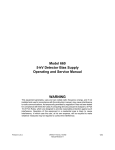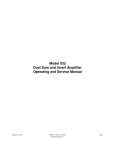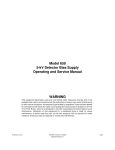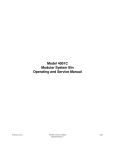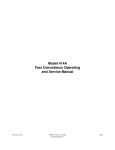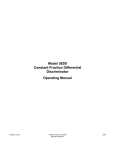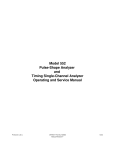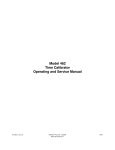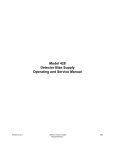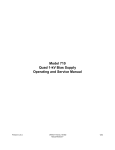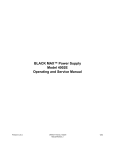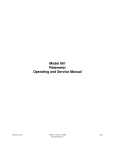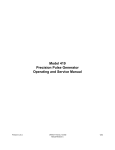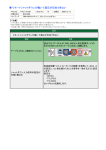Download Model 9302 Amplifier-Discriminator Operating and Service Manual
Transcript
Model 9302
Amplifier-Discriminator
Operating and Service Manual
Printed in U.S.A.
ORTEC® Part No. 733690
Manual Revision C
1202
Advanced Measurement Technology, Inc.
a/k/a/ ORTEC®, a subsidiary of AMETEK®, Inc.
WARRANTY
ORTEC* warrants that the items will be delivered free from defects in material or workmanship. ORTEC makes
no other warranties, express or implied, and specifically NO WARRANTY OF MERCHANTABILITY OR
FITNESS FOR A PARTICULAR PURPOSE.
ORTEC’s exclusive liability is limited to repairing or replacing at ORTEC’s option, items found by ORTEC to
be defective in workmanship or materials within one year from the date of delivery. ORTEC’s liability on any
claim of any kind, including negligence, loss, or damages arising out of, connected with, or from the performance
or breach thereof, or from the manufacture, sale, delivery, resale, repair, or use of any item or services covered
by this agreement or purchase order, shall in no case exceed the price allocable to the item or service furnished
or any part thereof that gives rise to the claim. In the event ORTEC fails to manufacture or deliver items called
for in this agreement or purchase order, ORTEC’s exclusive liability and buyer’s exclusive remedy shall be release
of the buyer from the obligation to pay the purchase price. In no event shall ORTEC be liable for special or
consequential damages.
Quality Control
Before being approved for shipment, each ORTEC instrument must pass a stringent set of quality control tests
designed to expose any flaws in materials or workmanship. Permanent records of these tests are maintained for
use in warranty repair and as a source of statistical information for design improvements.
Repair Service
If it becomes necessary to return this instrument for repair, it is essential that Customer Services be contacted in
advance of its return so that a Return Authorization Number can be assigned to the unit. Also, ORTEC must be
informed, either in writing, by telephone [(865) 482-4411] or by facsimile transmission [(865) 483-2133], of the
nature of the fault of the instrument being returned and of the model, serial, and revision ("Rev" on rear panel)
numbers. Failure to do so may cause unnecessary delays in getting the unit repaired. The ORTEC standard
procedure requires that instruments returned for repair pass the same quality control tests that are used for
new-production instruments. Instruments that are returned should be packed so that they will withstand normal
transit handling and must be shipped PREPAID via Air Parcel Post or United Parcel Service to the designated
ORTEC repair center. The address label and the package should include the Return Authorization Number
assigned. Instruments being returned that are damaged in transit due to inadequate packing will be repaired at the
sender's expense, and it will be the sender's responsibility to make claim with the shipper. Instruments not in
warranty should follow the same procedure and ORTEC will provide a quotation.
Damage in Transit
Shipments should be examined immediately upon receipt for evidence of external or concealed damage. The carrier
making delivery should be notified immediately of any such damage, since the carrier is normally liable for damage
in shipment. Packing materials, waybills, and other such documentation should be preserved in order to establish
claims. After such notification to the carrier, please notify ORTEC of the circumstances so that assistance can be
provided in making damage claims and in providing replacement equipment, if necessary.
Copyright © 2002, Advanced Measurement Technology, Inc. All rights reserved.
*ORTEC® is a registered trademark of Advanced Measurement Technology, Inc. All other trademarks used
herein are the property of their respective owners.
iii
CONTENTS
WARRANTY . . . . . . . . . . . . . . . . . . . . . . . . . . . . . . . . . . . . . . . . . . . . . . . . . . . . . . . . . . . . . . . . . . . . . . . ii
SAFETY INSTRUCTIONS AND SYMBOLS . . . . . . . . . . . . . . . . . . . . . . . . . . . . . . . . . . . . . . . . . . . . . . . iv
SAFETY WARNINGS AND CLEANING INSTRUCTIONS . . . . . . . . . . . . . . . . . . . . . . . . . . . . . . . . . . . . . v
1. DESCRIPTION . . . . . . . . . . . . . . . . . . . . . . . . . . . . . . . . . . . . . . . . . . . . . . . . . . . . . . . . . . . . . . . . . . .
1.1. GENERAL . . . . . . . . . . . . . . . . . . . . . . . . . . . . . . . . . . . . . . . . . . . . . . . . . . . . . . . . . . . . . . . .
1.2. INPUT SIGNALS . . . . . . . . . . . . . . . . . . . . . . . . . . . . . . . . . . . . . . . . . . . . . . . . . . . . . . . . . . .
1.3. OUTPUTS . . . . . . . . . . . . . . . . . . . . . . . . . . . . . . . . . . . . . . . . . . . . . . . . . . . . . . . . . . . . . . . .
1
1
1
1
2. SPECIFICATIONS . . . . . . . . . . . . . . . . . . . . . . . . . . . . . . . . . . . . . . . . . . . . . . . . . . . . . . . . . . . . . . . .
2.1. PERFORMANCE . . . . . . . . . . . . . . . . . . . . . . . . . . . . . . . . . . . . . . . . . . . . . . . . . . . . . . . . . . .
2.2. CONTROLS . . . . . . . . . . . . . . . . . . . . . . . . . . . . . . . . . . . . . . . . . . . . . . . . . . . . . . . . . . . . . . .
2.3. INPUT . . . . . . . . . . . . . . . . . . . . . . . . . . . . . . . . . . . . . . . . . . . . . . . . . . . . . . . . . . . . . . . . . . .
2.4. OUTPUTS . . . . . . . . . . . . . . . . . . . . . . . . . . . . . . . . . . . . . . . . . . . . . . . . . . . . . . . . . . . . . . . .
2.5. ELECTRICAL AND MECHANICAL . . . . . . . . . . . . . . . . . . . . . . . . . . . . . . . . . . . . . . . . . . . . . .
1
1
1
2
2
2
3. INSTALLATION . . . . . . . . . . . . . . . . . . . . . . . . . . . . . . . . . . . . . . . . . . . . . . . . . . . . . . . . . . . . . . . . . .
3.1. GENERAL . . . . . . . . . . . . . . . . . . . . . . . . . . . . . . . . . . . . . . . . . . . . . . . . . . . . . . . . . . . . . . . .
3.2. CONNECTION TO POWER . . . . . . . . . . . . . . . . . . . . . . . . . . . . . . . . . . . . . . . . . . . . . . . . . . .
3.3. INPUT/OUTPUT CONNECTIONS . . . . . . . . . . . . . . . . . . . . . . . . . . . . . . . . . . . . . . . . . . . . . .
2
2
2
2
4. MAINTENANCE . . . . . . . . . . . . . . . . . . . . . . . . . . . . . . . . . . . . . . . . . . . . . . . . . . . . . . . . . . . . . . . . . . 3
4.1. CORRECTIVE MAINTENANCE . . . . . . . . . . . . . . . . . . . . . . . . . . . . . . . . . . . . . . . . . . . . . . . . 3
4.2. FACTORY REPAIR SERVICE . . . . . . . . . . . . . . . . . . . . . . . . . . . . . . . . . . . . . . . . . . . . . . . . . 3
5. APPLICATIONS . . . . . . . . . . . . . . . . . . . . . . . . . . . . . . . . . . . . . . . . . . . . . . . . . . . . . . . . . . . . . . . . . . 3
iv
SAFETY INSTRUCTIONS AND SYMBOLS
This manual contains up to three levels of safety instructions that must be observed in order to avoid
personal injury and/or damage to equipment or other property. These are:
DANGER
Indicates a hazard that could result in death or serious bodily harm if the safety instruction
is not observed.
WARNING
Indicates a hazard that could result in bodily harm if the safety instruction is not observed.
CAUTION
Indicates a hazard that could result in property damage if the safety instruction is not
observed.
Please read all safety instructions carefully and make sure you understand them fully before attempting to
use this product.
In addition, the following symbol may appear on the product:
ATTENTION–Refer to Manual
DANGER–High Voltage
Please read all safety instructions carefully and make sure you understand them fully before attempting to
use this product.
v
SAFETY WARNINGS AND CLEANING INSTRUCTIONS
DANGER
Opening the cover of this instrument is likely to expose dangerous voltages. Disconnect the
instrument from all voltage sources while it is being opened.
WARNING Using this instrument in a manner not specified by the manufacturer may impair the
protection provided by the instrument.
Cleaning Instructions
To clean the instrument exterior:
! Unplug the instrument from the ac power supply.
! Remove loose dust on the outside of the instrument with a lint-free cloth.
! Remove remaining dirt with a lint-free cloth dampened in a general-purpose detergent and water
solution. Do not use abrasive cleaners.
CAUTION To prevent moisture inside of the instrument during external cleaning, use only enough liquid
to dampen the cloth or applicator.
!
Allow the instrument to dry completely before reconnecting it to the power source.
vi
1
ORTEC MODEL 9302
AMPLIFIER-DISCRIMINATOR
1. DESCRIPTION
1.1. GENERAL
The ORTEC 9302 is a fast amplifier and
discriminator in a single-wide NIM-standard module
designed for use with photomultiplier or electron
multiplier tubes in photon, ion, or electron counting
applications. Features of the 9302 include a
wideband, high-gain amplifier and an integral
discriminator capable of counting rates up to 100
MHZ.
Incorporated in the module is a rate monitor system
that can be used to perform external switching
when the pulse counting rate is modulated. At
counting rates above those set by the front panel
selector switch, a voltage of greater than 2.0 V will
be present at the signal monitor connector. At
counting rates below the rate selected, 0 ± 0.2 V will
be present at the signal monitor connector.
1.2. INPUT SIGNALS
The input signals are dc-coupled into an impedance
of 50 . The maximum amplitude range of the
S
amplifier to retain linearity is 50 mV when the gain
switch is set at X20 and is 5 mV when the gain
switch is set at X200. Protection is provided for
input voltages of up to ±100 V at a 10% duty cycle.
1.3. OUTPUTS
The linear amplifier output connector is located on
the rear panel of the module and has an output
impedance of 50 . Use of this output requires 50
coaxial cable and 50 termination.
S
S
S
Two discriminator output connectors are also
located on the rear panel of the module. They are
isolated from each other and produce a negative
current pulse of 16 mA into a 50 load impedance.
The output pulse width is 5.0 ns.
#
S
The rear panel signal monitor connector produces
a positive dc voltage when the counting rate after
the discriminator is greater than the rate selected
on the front panel for the monitor rate discriminator.
When the counting rate is below the selected rate,
0 ± 0.2 V appears at the signal monitor output.
2. SPECIFICATIONS
2.1. PERFORMANCE
DISCRIMINATOR
Threshold Range 50 mV to 1 V.
AMPLIFIER
#2.0 ns from X2 to X20 threshold.
Voltage Range 0 to 50 mV.
Walk
Rise Time Typically 3.0 ns.
Pulse Pair Resolution <10 ns; 9 ns typically.
Noise
#10 :V for maximum gain.
2.2. CONTROLS
Gain Switch-selectable, X20 or X200.
Nonlinearity
#±1%.
Temperature Instability Gain, <0.1%/°C; dc drift,
<50 V/°C.
:
Gain Slide switch for selection of X20 or X200.
Disc Level
Multiturn control adjusts
discriminator level from 50 mV to 1 V.
the
2
Monitor Rate Disc Front panel potentiometer
selects 1 kHz, 10 kHz, 100 kHz, or 1 MHZ, which
determines the rate above which a logic level will
be produced.
Signal Mon BNC connector on rear panel provides
0 ± 0.2 V when discriminator count rate is below
threshold and +2.0 V when it is above threshold.
2.3. INPUT
Preamp Power Amphenol type 17-10090 connector
on rear panel; provides necessary power for 9301
Fast Preamplifier.
Amplifier In BNC connector on rear panel accepts
negative input signals; protected to ±100 V at 10%
duty factor; Zin - = 50 .
S
2.4. OUTPUTS
Amp Out Rear panel BNC connector provides
linear analog output; Zo = 50 .
S
Disc Out 2 independent BNC connectors on rear
panel provide negative current pulse of 16 mA into
50 ; width, 5 ns; rise time, 1.5 ns.
S
$
2.5. ELECTRICAL AND MECHANICAL
Power Required
-24V, 90 mA; -12V, 205 mA;
+24V, 85mA; +12V, 140 mA.
Dimensions NIM-standard single-width module
(1.35 by 8.714 in.) per TID-20893.
#
3. INSTALLATION
3.1. GENERAL
Since the 9302, in conjunction with an ORTEC
4001A/ 4002A Bin and Power Supply, is intended
for rack mounting, vacuum tube equipment
operating in the same rack must be sufficiently
cooled with circulating air to prevent any localized
heating of the all-transistorized circuitry used
throughout the 9302. The temperature of equipment
mounted in racks can easily exceed the
recommended maximum limit of 120°F (50°C)
unless these precautions are taken.
3.2. CONNECTION TO POWER
The 9302 contains no internal power supply, and
must obtain the necessary dc operating power from
the 4001A/ 4002A Bin and Power Supply in which
it is installed for operation. Always turn off power on
the Power Supply before inserting or removing
modules. The ORTEC 9000 Series of modular
instruments is designed so that the Power Supply
cannot be overloaded when there is a full
complement of modules in the Bin. Since, however,
this may not be true when the Bin contains modules
other than those of ORTEC design, use the
convenient test points on the front panel of the
4001A/4002A to check each Power Supply voltage
level after all modules have been inserted.
3.3. INPUT/OUTPUT CONNECTIONS
S
The low input impedance (50 ) and low output
impedance (50 ) of the 9302 permit it to be used
in a system using only 50 cable. The low output
impedance requires that the output cable be
terminated by the characteristic impedance of the
cable at the remote cable end.
S
S
3
4. MAINTENANCE
4.1. CORRECTIVE MAINTENANCE
Table 4.1. dc Bias Points (Nominal Values).
The ORTEC 9302 should require no regular
maintenance other than replacement of
components that have failed due to age. Always
ensure that the replacement components are
equivalent to the original parts, designated in
schematic 9302-0101-S1. No internal trimming or
adjustment is necessary with the 9302.
To aid in the identification of a malfunctioning
component, typical stage-by-stage dc voltages are
shown in Table 4.1. These voltages are typical
values, and may vary through a narrow range
without indicating a fault.
4.2. FACTORY REPAIR SERVICE
This instrument can be returned to the ORTEC
factory for service and repair at a nominal cost. Our
standard procedure for repair ensures the same
quality control and checkout that are used for a new
instrument. Always contact the Customer Service
Department at ORTEC, (865) 483-2231, before
sending in an instrument for repair for shipping
instructions and so that the required Return
Authorization Number can be assigned to the unit.
This number should be written on the address label
and on the package.
5. APPLICATIONS
There are a number of different applications for the
9302 Amplifier-Discriminator. However, since the
unit was designed primarily for ion, electron, and
photon counting, system block diagrams for this
type of usage are given.
Figure 5.1 is a block diagram of a system that might
be used to perform atomic or molecular
fluorescence measurements. Pulses from the
photomultiplier tube are applied to the 9302, where
they are first amplified. Following amplification, the
pulses enter the discriminator section of the 9302,
where those pulses whose amplitudes correspond
to photons are accepted. Pulses that correspond to
interdyode noise are of a lower voltage amplitude
and are rejected. The discriminator output is then
applied to the ORTEC 9349 Log/Lin Ratemeter.
The 9349 measures the average count rate of the
input pulses and also provides an analog output for
the y-deflection of the x-y recorder.
An analogous application to low-level light
measurements is ion counting. This technique can
be applied to mass spectrometry, and has the same
sensitivity advantages with an electron or ion
multiplier that are obtained by other detectors such
as photomultiplier tubes. A typical system that
could be used is shown in Fig. 5.2.
4
Fig. 5.1. Block Diagram of a Typical 1 MHZ Ratemeter System.
Fig. 5.2. Ion Counting System with Digital and Analog Outputs.
5
Bin/Module Connector Pin Assignments
For Standard Nuclear Instrument
Modules per DOE/ER-0457T.
Pin
1
2
3
4
5
6
7
8
9
*10
*11
12
13
14
15
*16
*17
18
19
20
21
22
Function
+3 V
-3V
Spare bus
Reserved bus
Coaxial
Coaxial
Coaxial
200 V dc
Spare
+6 V
-6V
Reserved bus
Spare
Spare
Reserved
+12 V
- 12 V
Spare bus
Reserved bus
Spare
Spare
Reserved
Pin
23
24
25
26
27
*28
*29
30
31
32
*33
*34
35
36
37
38
39
40
*41
*42
G
Function
Reserved
Reserved
Reserved
Spare
Spare
+24 V
- 24 V
Spare bus
Spare
Spare
117 V ac (hot)
Power return ground
Reset (Scaler)
Gate
Reset (Auxiliary)
Coaxial
Coaxial
Coaxial
117 V ac (neutral)
High-quality ground
Ground guide pin
Pins marked (*) are installed and wired in
ORTEC’s 4001A and 4001C Modular System
Bins.











